Which Land Animal has the Longest Tail? Lizards, Monkeys, Rodents
Animal tails are for balance, climbing, and attracting females. Which land animal has the longest tail? In this post, you’ll learn about the longest tails: by overall length and by a ratio of their body length.
The giraffe has the longest tail of all land animals, at 39 inches (1 meter). With a tail over three times its body length, the Asian grass lizard is the land animal with the longest tail to body ratio. Its 12-inch total body length includes a 9-inch tail.
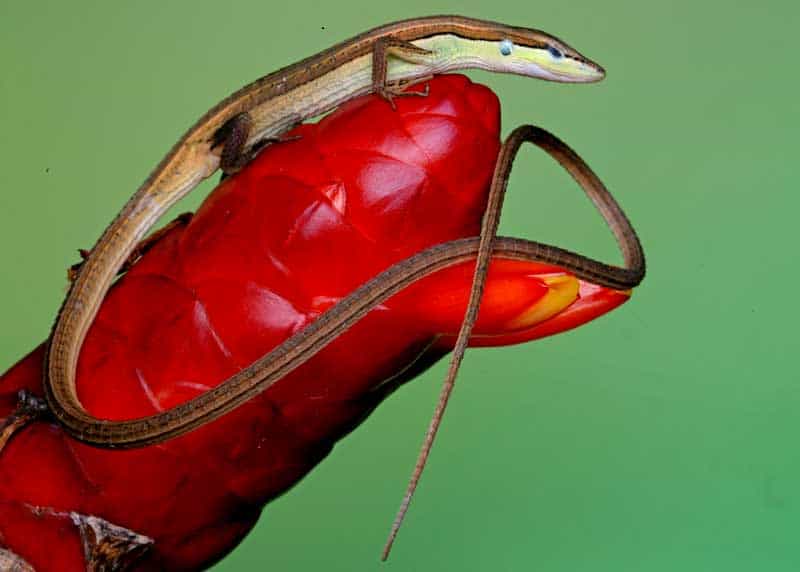
The Asian grass lizard is not the only land animal with a tail longer than its body.
Read on to discover more animals with tails that are notable for their size (whether it’s relative to their body, or just large in general!)
7 Land Animals with the Longest Tail to Body Ratio
Asian Grass Lizard (Long-tailed Grass Lizard)
- Tail to Body Ratio: 3:1
- Body Length: 3 inches (7.5 cm)
- Tail Length: 9 inches (23 cm)
- Total Length: 12 inches (30.5 cm)
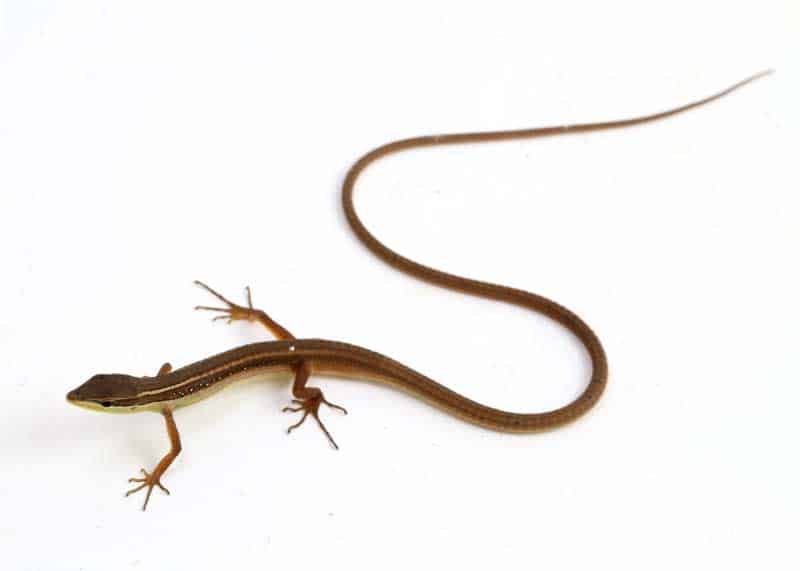
The Asian grass lizard (Takydromus sexlineatus) has a tail that often helps it balance as well as helps ward off predators.
A notable feature is that the Asian grass lizard can drop and regrow its tail when threatened.
This lizard has a body length that can reach 12 inches, with 9 inches of it being the tail, making it over three times its total body length. This is the land animal with the longest tail-to-body ratio.
You might mistake this reptile for a snake at first, but it has four small legs if you look closely.
This lengthy lizard is known as the six-striped long-tailed grass lizard, long-tailed grass lizard, or Asian grass lizard.
It is found throughout South East Asia, including China, Thailand, India, and Indonesia.
Here’s why lizards do push ups.
Long-Eared Jerboa
- Tail to Body Ratio: 2:1
- Body Length: 3 inches (7.5 cm)
- Tail Length: 6 inches (15.2 cm)
- Total Length: 9 inches (23 cm)
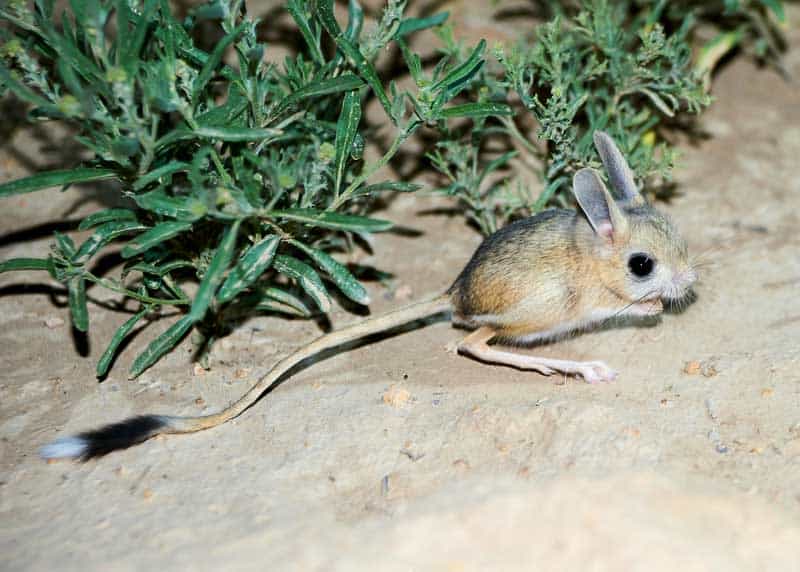
The long-eared jerboa (Euchoreutes naso), just like the Asian grass lizard, has a long tail in order to help it balance.
The long-eared jerboa has a very small body of 3 inches, with a long tail up to 6.5 inches, which is two times its body length.
As this squirrel-like animal with a long tail jumps horizontally and vertically several feet, its tail assists in balancing, helping it travel from place to place and avoid predators.
Slender Glass Lizard
- Tail to Body Ratio: 1.95:1
- Body Length: 10 inches (25.5 cm)
- Tail Length: 19.5 inches (49.5 cm)
- Total Length: 29.5 inches (75 cm)
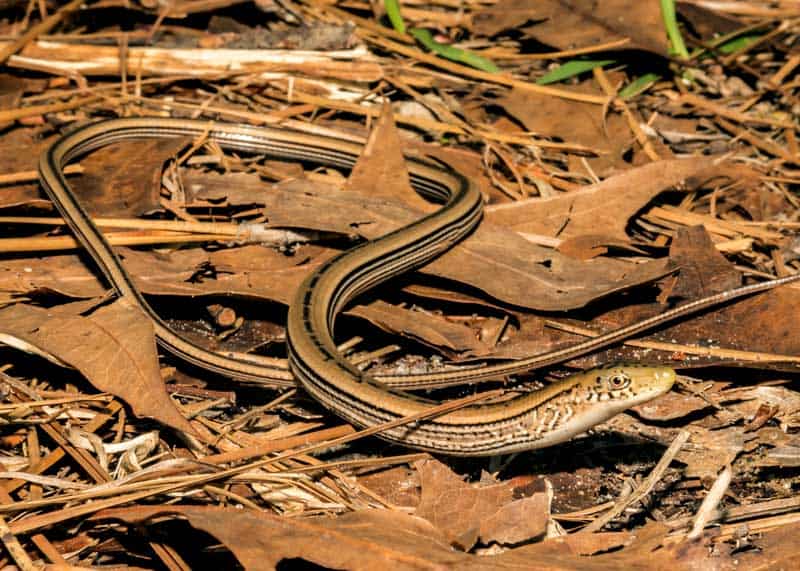
The glass lizard (Ophisaurus attenuatus) is no ordinary lizard. Not only does it have one of the longest tails on a land animal, but it also does not have any legs.
Despite this, it is still classified as a lizard because it does not have all the characteristics of a snake.
Unlike a snake, this lizard has moveable eyelids, external ear openings, and cannot open its jaw as wide.
Additionally, this lizard’s tail can drop and regrow its tail when threatened, which a snake cannot do.
On average, this lizard has a total length of just under 30 inches but can range from 22 to 42 in (62 to 107 cm).
Spider Monkey
- Tail to Body Ratio: 1.68:1
- Body Length: 19 inches (48 cm)
- Tail Length: 32 inches (81 cm)
- Total Length: 51 inches (129 cm)
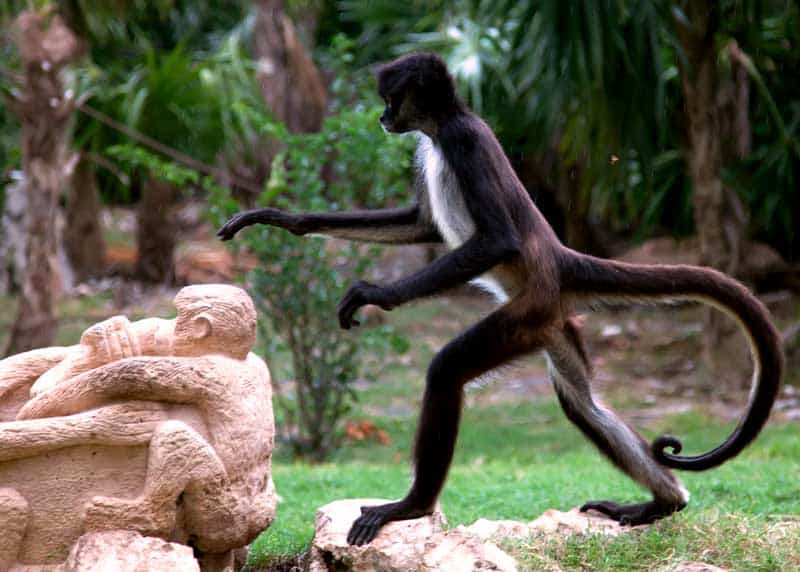
Spider monkeys (Ateles fusciceps robustus) also have long tails, reaching about 1.9 times their body length. With aid from the tail, their arms and legs help them to climb trees and leap from branch to branch to travel quickly.
The tail is also strong enough for the monkeys to hang without any support from their hands or legs.
The spider monkey’s total body can reach up to 26 inches, with the majority of that length coming from its tail.
Spider monkeys can be found in the jungles of Central America and the Amazon rainforest of South America.
Ring-Tailed Lemur
- Tail to Body Ratio: 1.4:1
- Body Length: 17 inches (43 cm)
- Tail Length: 24 inches (61 cm)
- Total Length: 41 inches (104 cm)
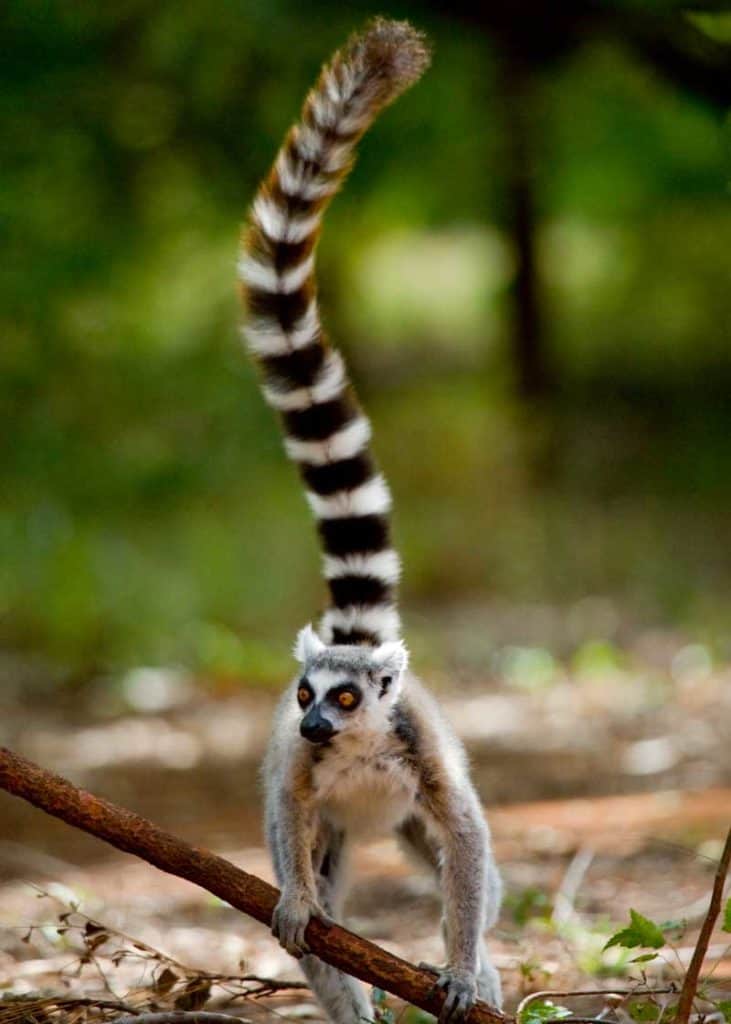
Just like the spider monkey, the ring-tailed lemur (Lemur catta) uses its tail for balance and for assistance in travel.
In total, this monkey can reach up to 43 inches long, with a tail making up 25 inches of that length
This monkey spends more time on the ground than the average primate but can jump up to 10 feet. Its tail also assists in balance when it jumps, stands, or navigates its surroundings.
Angola Colobus Monkey
- Tail to Body Ratio: 1.22:1
- Body Length: 27 inches (69 cm)
- Tail Length: 33 inches (84 cm)
- Total Length: 60 inches (152 cm)
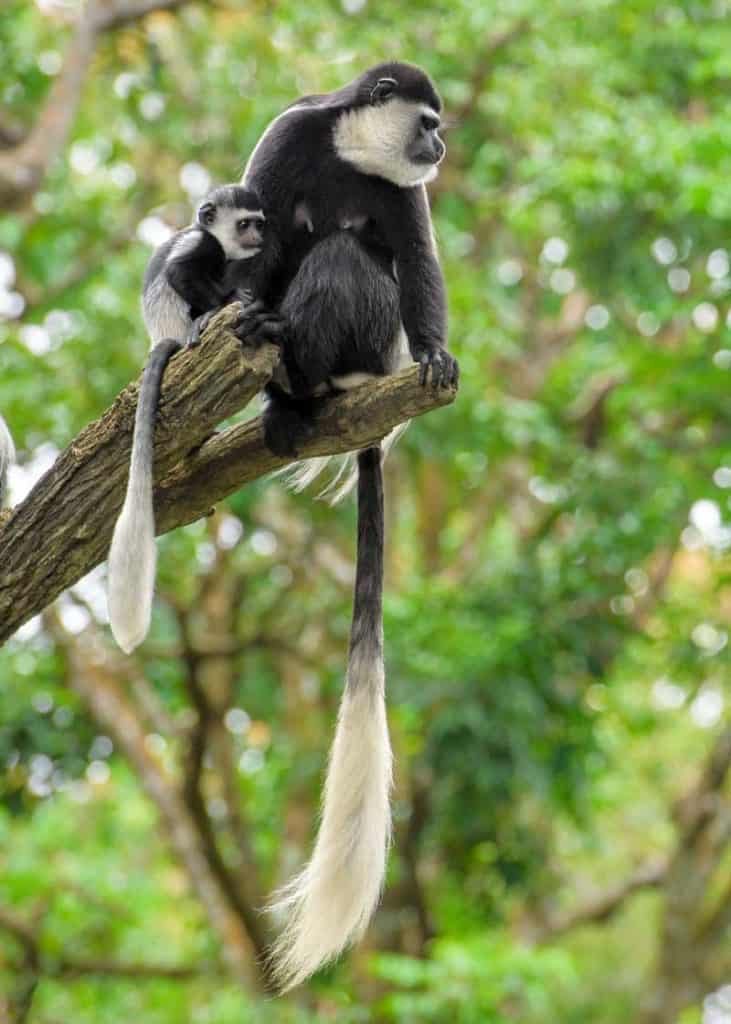
The Angola colobus monkey (Colobus angolensis) is native to Africa.
Males have an average of 27 inches body length, with their tail adding another 33 inches. Females are slightly smaller at 19-inch body and 28-inch tails, giving them a tail-to-body ratio of 2:1.
This long appendage also aids in balancing its body along the tops of branches of trees. It can also move its tail as well as a method of communication.
Body language is important to monkeys and the tail is a great form of communication!
Giraffe
- Tail to Body Ratio: 0.4:1
- Body Length: 96 inches (244 cm)
- Tail Length: 39 inches (99 cm)
- Total Length: 135 inches (343 cm)
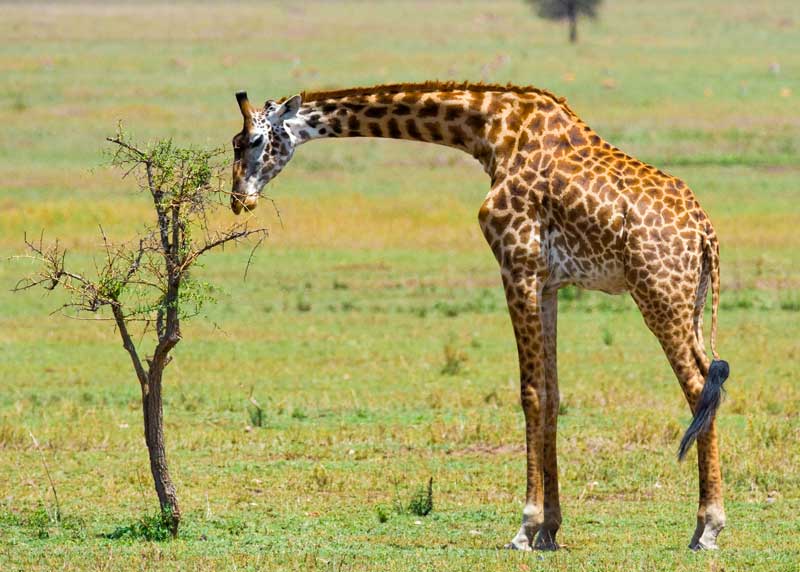
Not only is the giraffe (Giraffa) the tallest land animal, but it also has the longest tail on record, reaching up to 3.3 feet long.
But because of the giraffe’s immense size, it does not have the longest tail-to-body ratio. In fact, it actually has the lowest ratio of all the animals on this list.
Are Giraffe Tails Really 8 Feet Long?
Are giraffe tails really 8 feet long? No. Although being cited by countless low-quality sites, I can’t find a single reference to back up this extraordinary claim. From what I found, the average giraffe tail is 39″ (1 meter) (Source: Britannica).
Have a reference to show that they’re longer than 3 feet? Let me know in the comments.
Giraffes use their tail to flick off flies and other insects.
Giraffe tails are commonly sought after in poaching as their tail hairs are used to make jewelry and common household items like flyswatters and thread.
The giraffe genus is made up of 4 species and 5 subspecies.
3 Other Animals with a High Tail to Body Ratio
Land animals are not the only ones with long tails.
While these creatures do not quite qualify as “land animals,” their tails are just as impressive and important to their survival.
Long-tailed Widowbird (Males)
- Tail Length: 20 inches (51 cm)
- Tail is 4 times longer than their body
This bird has a set of tail feathers that can reach up to four times its body length.
While the female long-tailed widowbird has a “normal” sized tail, the male long-tailed widowbird (Euplectes progne) can have a tail that reaches up to 20 inches beyond its body.
These tails are used not only to attract a mate but as a way to protect their territory. As they fly over, these feathers help the bird appear larger than they actually are, scaring away any potential threats.
Whiptail stingray
Whiptail stingrays are marine animals that have a barbed tail that can reach up to three times their body length.
They often spend their time in the sand, hunting their prey of mollusks, crustaceans, jellyfish, and other bony fishes.
They use their tail only as a defensive mechanism, using their barbs to release venom into the threat at hand.
Ribbon-Tailed Astrapia (Males)
- Tail Length: 49 inches (125 cm)
This beautiful bird is part of the bird-of-paradise family. The Ribbon-Tailed Astrapia can have multi-colored tail feathers up to 49 inches (125 cm) long.
While these tails are gorgeous and can help them in attracting a mate, they can get caught in the forest around them, causing them to get stuck and put themselves at risk for predators.
Despite this risk, females often search for the perfect type of tail feathers (and genes) when making mating decisions.
Keep reading: 13 Fastest Animals in Africa and 9 Largest Eagles in the World
You might also enjoy 18 Facts About African Fat-Tailed Geckos – a lizard that can drop its tail when threatened.
Your turn
Have an animal to add to the list? Let me know in the comments.







National Geographic also make the 8 foot tail claim.
Thanks Matt. This isn’t surprising. National Geographic even confuses the difference between venomous and poisonous. They know how to shoot good footage but their actual content (spoken and written) is often sloppy. We’ve stopped using them as research sources because of this.